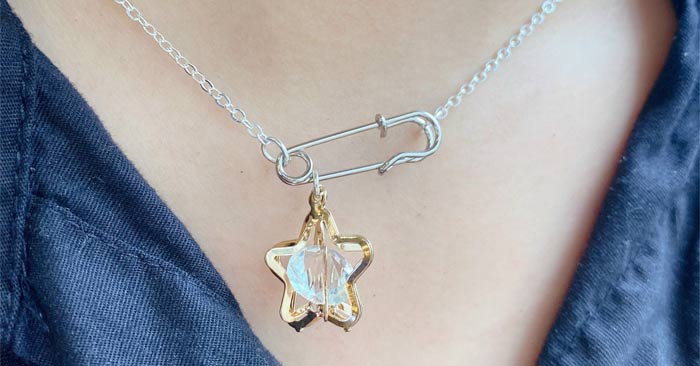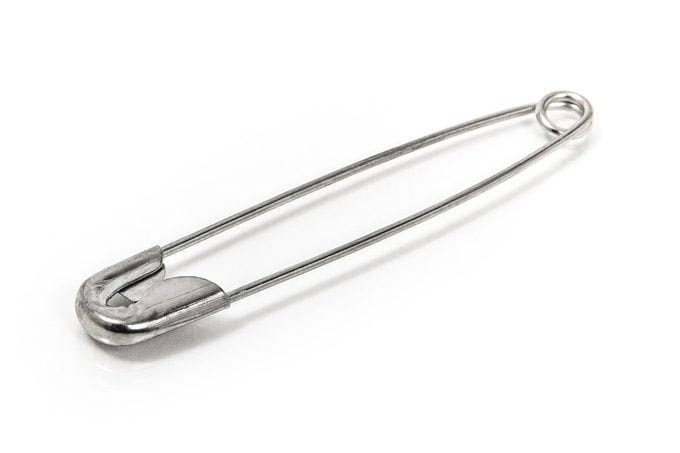What is the round hole on a safety pin used for?
Safety pins are familiar items in our daily lives. However, do you know the uses of the round holes on safety pins ? Let's find out together!

Safety pins are everywhere—sewing kits, first aid kits, diaper bags—and chances are you have a few lying around in your junk drawer or buried in the bottom of your purse right now.
Most of us probably haven't spent much time thinking about the anatomy of a safety pin. We just grab one for emergencies—a broken zipper, a loose shirt hem, a rebel bra strap—and hope we don't stab ourselves in the process. But the next time you're dealing with a wardrobe malfunction, take a closer look. See that little hole in the pin? That's not a flaw. That's not a design quirk. In fact, that's the secret to the pin's superpowers .
Why do safety pins have round holes?
There are actually two holes on a safety pin: one at the top where the pin is, and one at the bottom. Both serve a purpose other than looking like little design features. The hole at the top where the pin is helps relieve some of the pressure so you can bend the pin more easily when opening and closing it. The hole at the bottom is the spring mechanism that helps the pin pop out.
Obviously, it's not that hard to shape a safety pin. But there's more design in that little metal coil than you might initially notice. For example, that hole at the bottom is also where the wire is anchored during manufacturing, before it's twisted into that tight coil.
Purpose of holes in safety pins
Once the hole is created, it continues to serve a purpose: to maintain spring tension. That's the "magic" that keeps the safety latch closed and in place, rather than opening up and turning your lost button situation into an emergency tetanus shot.
Without the tension created by the coil—and reinforced by that bottom hole—the pin wouldn't close itself. It would just be a wire with shaping problems.
Origin of the hole in the safety pin
The genius of the modern safety pin dates back to the 19th century, when a man named Walter Hunt had a problem to solve. Specifically, Hunt was reportedly trying to pay off a $15 debt (which may be related), and in 1849, he was running out of options. As the story goes, one day, while deep in thought, he fiddled with a piece of wire and discovered that he had created a loop that he could open and close. And that's how the safety pin was born. He patented his invention and sold it for a few hundred dollars, surely not knowing that it would become a staple item centuries later.
The round hole was part of the design from the beginning because it was an integral part of how the entire mechanism worked. However, as the safety pin evolved over time, there have been a number of new designs for safety pins, and not all of them have the hole at the bottom.

Types of safety pins
There are dozens of different types of safety pins out there—many of which you've probably never heard of, but which are quietly working behind the scenes in everything from fashion shows to laundry rooms. These little guys are used for hundreds of creative (and sometimes bizarre) purposes. Here are just a few of the most common:

- Traditional safety pins: These come in three basic sizes—creatively labeled 1, 2, and 3—and are the standard choice for household repairs, quick hems, broken straps, and last-minute clothing alterations.
- Black Safety Pins: These are the stealth ninjas of the safety pin world. They are used in Hollywood and on photo shoots because they are invisible to the camera. Their matte black finish keeps them from reflecting light, allowing stylists and set designers to work their 'magic' without giving away their secrets.
- Steel No-Coil Safety Pins: No coils, no snags. These pins are specially designed without the traditional hole-making coil at the end, making them ideal for delicate or loosely woven fabrics (like knits, lace, or tulle). They slide through without snagging or pulling, so your favorite sweater will always be as perfect as possible.
You should read it
- How to drop a pin on Google Maps
- How to Find Vehicle Safety Ratings
- Check the safety of links, web pages
- How to install CPU into Mainboard properly, without bent pins
- Why is there a small hole in the plastic seat, not another?
- The Germans will check elevator safety at the 246m high tower at a speed of 40mph / s in 2017
 What are the little dots on the apple?
What are the little dots on the apple? The world's unique church wonder, built for 140 years and still not finished, is stunningly magnificent
The world's unique church wonder, built for 140 years and still not finished, is stunningly magnificent Analyzing How Kabbalah Numerology Works
Analyzing How Kabbalah Numerology Works Love Compatibility According to Numerology: Meaning of the Levels
Love Compatibility According to Numerology: Meaning of the Levels The world's strongest magnet can generate a magnetic field of 45.22 tesla, one million times stronger than the Earth's magnetic field.
The world's strongest magnet can generate a magnetic field of 45.22 tesla, one million times stronger than the Earth's magnetic field. The Mystical Meaning of Angel Number 333
The Mystical Meaning of Angel Number 333